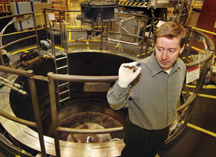Z accelerator pushes aluminum plates faster than Earth moves through space

The object, which resembled a small plate, slid smoothly from its launch site. By the time it traveled 1/6 of an inch, it had reached a velocity of 76,000 miles per hour, or 50 times the speed of a rifle bullet. In less than a second, the plate had gained approximately three times the velocity needed to escape Earth’s gravitational field.
No human could survive that enormous acceleration. The plate itself remained intact only because of the smoothly increasing thrust of the huge magnetic field driving it. A single sharp jolt would have vaporized the plate.
The speed of the thrust was a new record for Sandia’s electrically driven Z accelerator, sometimes referred to as the fastest gun in the West. Actually the fastest in the world, it is now able to propel small plates shocklessly at 34 kilometers a second, faster than the velocity Earth travels through space (30 km/sec) in its orbit about the sun.
The point of the achievement, however, is not speed for speed’s sake.
“Being able to send material so fast is not just for vanity or the Guinness Book of Records,” says Marcus Knudson (1646), lead scientist on the effort. “This is presently one of the few ways on earth to get hard information on problems that concern efforts at the outer reaches of science, rather than having to rely on complex speculations that may or may not be correct.”
Says Yogi Gupta, a professor known for his work in shock physics at the Washington State University in Pullman, “If you had asked me a few years ago if we could send something this fast, I would have said you were joking. But mankind is always trying to create conditions in the laboratory that imitate extreme conditions [found elsewhere].”
Data from the new work, made possible by an upgrade in Z’s firing mechanism, will help engineers more optimally design deuterium capsules to achieve peacetime nuclear fusion, an eventual source of low-environmental-impact electrical power. The high-pressure regimes also provide data for stewardship of the nuclear stockpile — data formerly impossible to come by except through a nuclear explosion in underground experiments.
By creating states of matter extremely difficult to achieve on Earth, the flyer plates also provide hard data to astrophysicists speculating on the structure and even the formation of planets like Jupiter and Saturn.
Says Didier Saumon, an astrophysicist at Los Alamos National Laboratory, “The internal structures of Jupiter and Saturn are composed mostly of hydrogen, so knowing its equation of state [how hydrogen and its isotopes behave at pressures from one to 50 million atmospheres] is highly relevant to how we infer the interior properties of these planets. Z gave us hard data.”
The results were reported at the March meeting of the American Physical Society.
The immediate purpose of these very rapid flights is to measure the response of materials at extreme conditions. Z’s hurled plates strike a target after traveling five millimeters. The impact generates a shock wave — in some cases, reaching 15 million times atmospheric pressure — that passes through the target material. The waves are so powerful that they do not merely penetrate or even pulverize the materials. They turn solids into liquids, liquids into gases, and gases into plasmas in the same way that heat melts ice to water or boils water into steam. The difference is that in the heart of the 120-foot-diameter accelerator, the process takes place at far higher temperatures and in much shorter times than the kitchen stove could ever approach. The pressures produce states of materials rarely seen or measured in the laboratory.
The trick in accelerating the fragile, 850-micron-thick aluminum plates at 10 to the 10th Gs (force of Earth’s gravity) without vaporizing them lies in the finer control now achievable of the magnetic field pulse driving the 30 mm by 15 mm fliers.
For Z’s better known effect — vaporizing fine wires at its center to create nuclear fusion — the trick is to get current to travel down Z’s 36 cables as simultaneously as possible, so that all the amperage strikes its target with as short a risetime as possible, approximately 100 nanoseconds.
To send a plate flying instead, the arrival of energy at the target is staggered over 300 nanoseconds, so that the amperage arrives less like a tidal wave surge and more in controllable increments.
This requirement was better achieved by a recent upgrade that removed a single laser formerly used to trigger current in all cables simultaneously. In its place, 36 laser switches were installed — one for each cable. This change permits researchers to shape the electrical pulse that arrives at the target, with a corresponding modulation in the magnetic field driving the plate.
An upgrade of Z planned for next year is expected to achieve plate velocities of 45 to 50 km/sec, says Marcus, driving targeted materials further into their plasma regime.
Z’s former record in propelling plates was 21 km/sec, set two years ago.